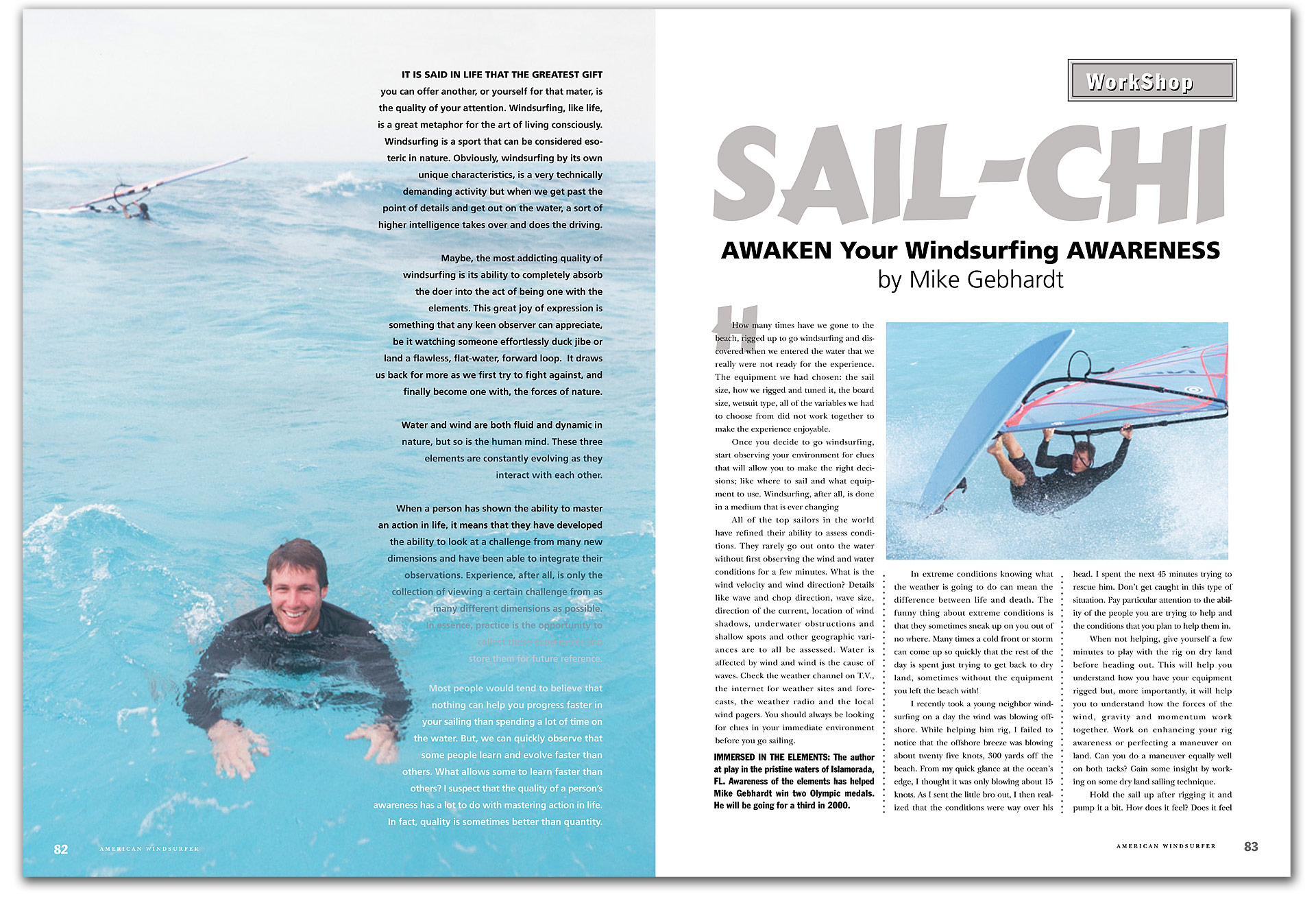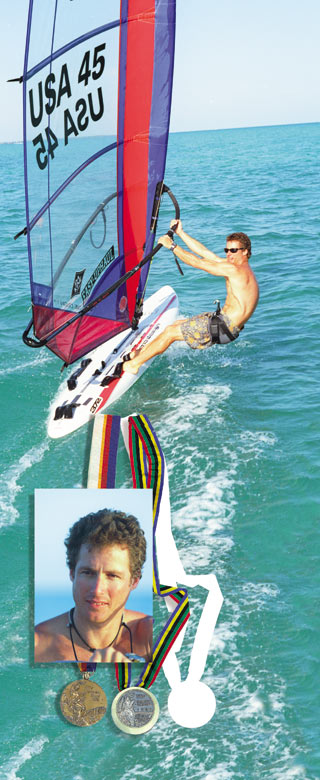
IT IS SAID in life that the greatest gift you can offer another, or yourself for that mater, is the quality of your attention. Windsurfing, like life, is a great metaphor for the art of living consciously. Windsurfing is a sport that can be considered esoteric in nature. Obviously, windsurfing by its own unique characteristics, is a very technically demanding activity but when we get past the point of details and get out on the water, a sort of higher intelligence takes over and does the driving.
Maybe, the most addicting quality of windsurfing is its ability to completely absorb the doer into the act of being one with the elements. This great joy of expression is something that any keen observer can appreciate, be it watching someone effortlessly duck jibe or land a flawless, flat-water, forward loop. It draws us back for more as we first try to fight against, and finally become one with, the forces of nature.
Water and wind are both fluid and dynamic in nature, but so is the human mind. These three elements are constantly evolving as they interact with each other.
When a person has shown the ability to master an action in life, it means that they have developed the ability to look at a challenge from many new dimensions and have been able to integrate their observations. Experience, after all, is only the collection of viewing a certain challenge from as many different dimensions as possible. In essence, practice is the opportunity to collect these experiences and store them for future reference.
Most people would tend to believe that nothing can help you progress faster in your sailing than spending a lot of time on the water. But, we can quickly observe that some people learn and evolve faster than others. What allows some to learn faster than others? I suspect that the quality of a person’s awareness has a lot to do with mastering action in life. In fact, quality is sometimes better than quantity.
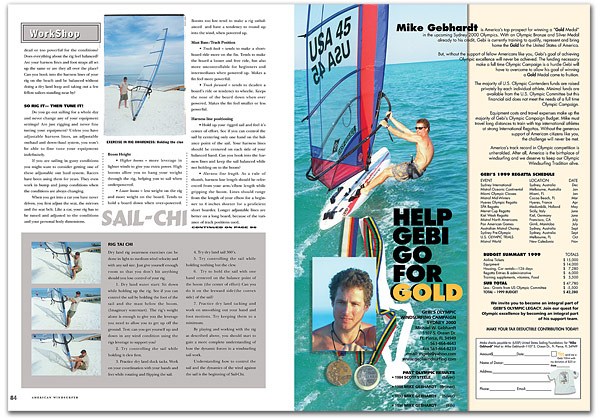
How many times have we gone to the beach, rigged up to go windsurfing and discovered when we entered the water that we really were not ready for the experience. The equipment we had chosen: the sail size, how we rigged and tuned it, the board size, wetsuit type, all of the variables we had to choose from did not work together to make the experience enjoyable.
Once you decide to go windsurfing, start observing your environment for clues that will allow you to make the right decisions; like where to sail and what equipment to use. Windsurfing, after all, is done in a medium that is ever changing.
Advertisement
All of the top sailors in the world have refined their ability to assess conditions. They rarely go out onto the water without first observing the wind and water conditions for a few minutes. What is the wind velocity and wind direction? Details like wave and chop direction, wave size, direction of the current, location of wind shadows, underwater obstructions and shallow spots and other geographic variances are to all be assessed. Water is affected by wind and wind is the cause of waves. Check the weather channel on T.V., the internet for weather sites and forecasts, the weather radio and the local wind pagers. You should always be looking for clues in your immediate environment before you go sailing.
In extreme conditions knowing what the weather is going to do can mean the difference between life and death. The funny thing about extreme conditions is that they sometimes sneak up on you out of no where. Many times a cold front or storm can come up so quickly that the rest of the day is spent just trying to get back to dry land, sometimes without the equipment you left the beach with!
I recently took a young neighbor windsurfing on a day the wind was blowing offshore. While helping him rig, I failed to notice that the offshore breeze was blowing about twenty five knots, 300 yards off the beach. From my quick glance at the ocean’s edge, I thought it was only blowing about 15 knots. As I sent the little bro out, I then realized that the conditions were way over his head. I spent the next 45 minutes trying to rescue him. Don’t get caught in this type of situation. Pay particular attention to the ability of the people you are trying to help and the conditions that you plan to help them in.
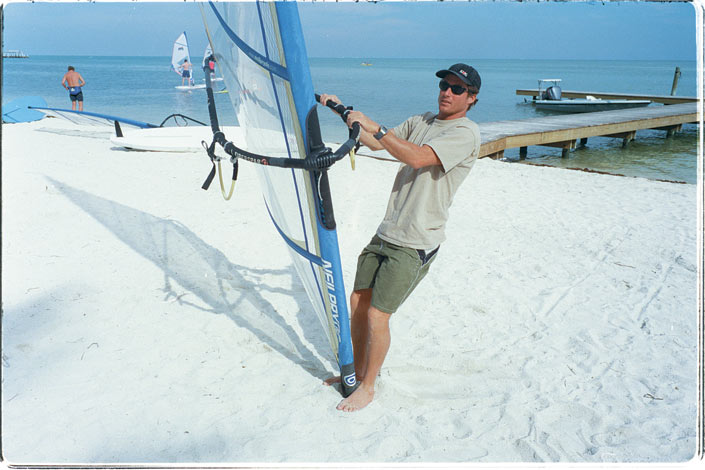
When not helping, give yourself a few minutes to play with the rig on dry land before heading out. This will help you understand how you have your equipment rigged but, more importantly, it will help you to understand how the forces of the wind, gravity and momentum work together. Work on enhancing your rig awareness or perfecting a maneuver on land. Can you do a maneuver equally well on both tacks? Gain some insight by working on some dry land sailing technique.
Hold the sail up after rigging it and pump it a bit. How does it feel? Does it feel dead or too powerful for the conditions? Does everything about the rig feel balanced? Are your harness lines and foot straps all set up the same or are they all over the place? Can you hook into the harness lines of your rig on the beach and be balanced without doing a dry land loop and taking out a few fellow sailors standing near by?
So Rig it— then tune it!
Do you go out sailing for a whole day and never change any of your equipment settings? Are just rigging and never fine tuning your equipment? Unless you have adjustable harness lines, an adjustable outhaul and down–haul system, you won’t be able to fine tune your equipment indefinitely.
If you are sailing in gusty conditions you might want to consider getting one of these adjustable out haul system. Racers have been using them for years. They even work in bump and jump conditions when the conditions are always changing.
When you get into a car you have never driven, you first adjust the seat, the mirrors and the seat belt. Like a car, your rig has to be tuned and adjusted to the conditions and your personal body dimensions.
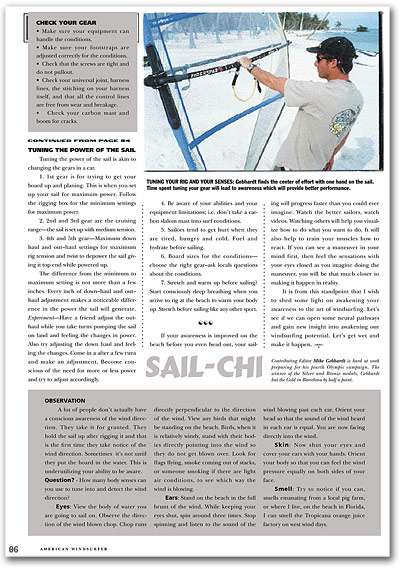
Boom Height
- Higher booms = more leverage in lighter winds to give you extra power. High booms allow you to hang your weight through the rig, helping you to sail when underpowered.
- Lower booms = less weight on the rig and more weight on the board. Tends to hold a board down when over–powered. Booms too low tend to make a rig unbalanced and have a tendency to round up into the wind, when powered up.
Advertisement
Mast Base/Track Position
- Track back = tends to make a shortboard ride more on the fin. Tends to make the board a looser and free ride, but also more uncontrollable for beginners and intermediates when powered up. Makes a fin feel more powerful.
- Track forward = tends to deaden a board’s ride or tendency to wheelie. Keeps the nose of the board down when over powered. Makes the fin feel smaller or less powerful.
Harness line positioning
- Hold up your rigged sail and feel it’s center of effort. See if you can control the sail by centering only one hand on the balance point of the sail. Your harness lines should be centered on each side of your balanced hand. Can you hook into the harness lines and keep the sail balanced while not holding on to the boom?
- Harness line length. As a rule of thumb, harness line length should be referenced from your arm/elbow length while gripping the boom. Lines should range from the length of your elbow for a beginner to 4 inches shorter for a proficient short boarder. Longer adjustable lines are better on a long board, because of the variance of track positions used.
Tuning the power of the sail
Tuning the power of the sail is akin to changing the gears in a car.
- 1st gear is for trying to get your board up and planing. This is when you set up your sail for maximum power. Follow the rigging box for the minimum settings for maximum power.
- 2nd and 3rd gear are the cruising range—the sail is set up with medium tension.
- 4th and 5th gear—Maximum down haul and out–haul settings for maximum rig tension and twist to depower the sail giving it top end while powered up.*
- Be aware of your abilities and your equipment limitations; i.e. don’t take a carbon slalom mast into surf conditions.
- Sailors tend to get hurt when they are tired, hungry and cold. Fuel and hydrate before sailing.
- Board sizes for the conditions— choose the right gear–ask locals questions about the conditions.
- Stretch and warm up before sailing? Start consciously deep breathing when you arrive to rig at the beach to warm your body up. Stretch before sailing like any other sport.
*The difference from the minimum to maximum setting is not more than a few inches. Every inch of down–haul and out–haul adjustment makes a noticeable difference in the power the sail will generate. Experiment—Have a friend adjust the outhaul while you take turns pumping the sail on land and feeling the changes in power. Also try adjusting the down haul and feeling the changes. Come in a after a few runs and make an adjustment. Become conscious of the need for more or less power and try to adjust accordingly.
If your awareness is improved on the beach before you even head out, your sailing will progress faster than you could ever imagine. Watch the better sailors, watch videos. Watching others will help you visualize how to do what you want to do. It will also help to train your muscles how to react. If you can see a maneuver in your mind first, then feel the sensations with your eyes closed as you imagine doing the maneuver, you will be that much closer to making it happen in reality.
It is from this standpoint that I wish to shed some light on awakening your awareness to the art of windsurfing. Let’s see if we can open some neural pathways and gain new insight into awakening our windsurfing potential. Let’s get wet and make it happen.
Contributing Editor Mike Gebhardt is hard at work preparing for his fourth Olympic campaign. The winner of the Silver and Bronze medals, Gebhardt lost the Gold in Barcelona by half a point.


